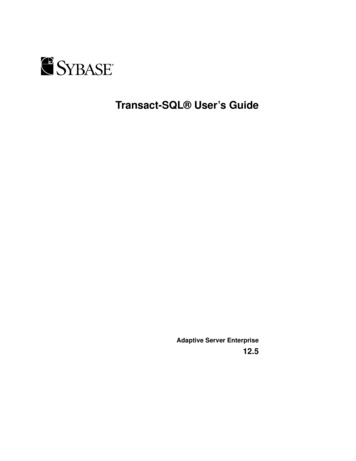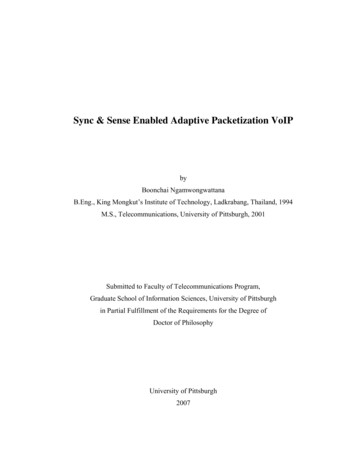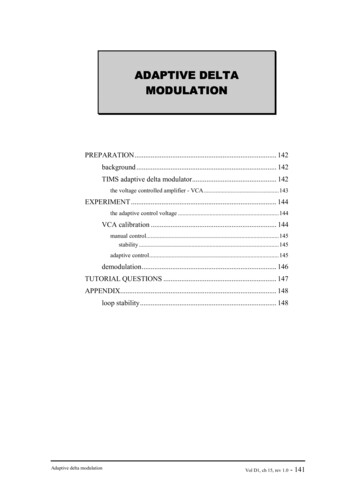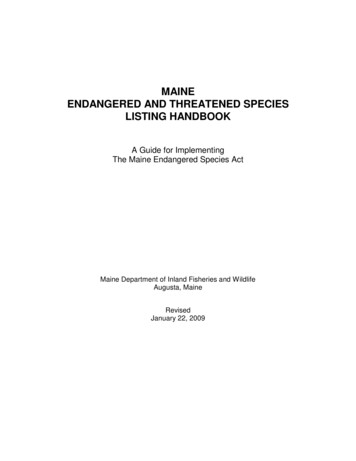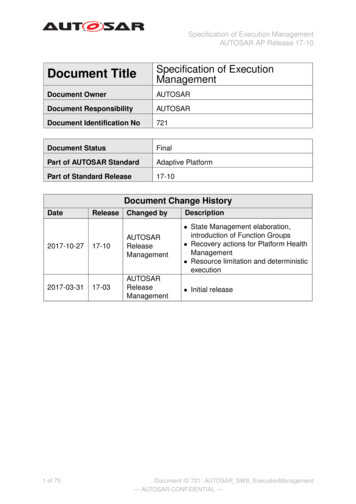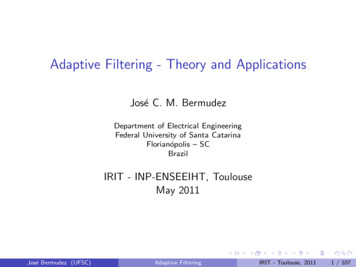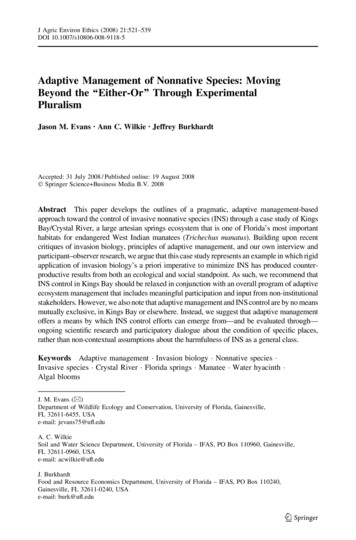
Transcription
J Agric Environ Ethics (2008) 21:521–539DOI 10.1007/s10806-008-9118-5Adaptive Management of Nonnative Species: MovingBeyond the ‘‘Either-Or’’ Through ExperimentalPluralismJason M. Evans Æ Ann C. Wilkie Æ Jeffrey BurkhardtAccepted: 31 July 2008 / Published online: 19 August 2008 Springer Science Business Media B.V. 2008Abstract This paper develops the outlines of a pragmatic, adaptive management-basedapproach toward the control of invasive nonnative species (INS) through a case study of KingsBay/Crystal River, a large artesian springs ecosystem that is one of Florida’s most importanthabitats for endangered West Indian manatees (Trichechus manatus). Building upon recentcritiques of invasion biology, principles of adaptive management, and our own interview andparticipant–observer research, we argue that this case study represents an example in which rigidapplication of invasion biology’s a priori imperative to minimize INS has produced counterproductive results from both an ecological and social standpoint. As such, we recommend thatINS control in Kings Bay should be relaxed in conjunction with an overall program of adaptiveecosystem management that includes meaningful participation and input from non-institutionalstakeholders. However, we also note that adaptive management and INS control are by no meansmutually exclusive, in Kings Bay or elsewhere. Instead, we suggest that adaptive managementoffers a means by which INS control efforts can emerge from—and be evaluated through—ongoing scientific research and participatory dialogue about the condition of specific places,rather than non-contextual assumptions about the harmfulness of INS as a general class.Keywords Adaptive management Invasion biology Nonnative species Invasive species Crystal River Florida springs Manatee Water hyacinth Algal bloomsJ. M. Evans (&)Department of Wildlife Ecology and Conservation, University of Florida, Gainesville,FL 32611-6455, USAe-mail: jevans75@ufl.eduA. C. WilkieSoil and Water Science Department, University of Florida – IFAS, PO Box 110960, Gainesville,FL 32611-0960, USAe-mail: acwilkie@ufl.eduJ. BurkhardtFood and Resource Economics Department, University of Florida – IFAS, PO Box 110240,Gainesville, FL 32611-0240, USAe-mail: burk@ufl.edu123
522J. M. Evans et al.1 IntroductionToday’s ecosystem managers invest large amounts of time, money, and effort on programs that aim to control and/or eliminate invasive nonnative species (INS). On the faceof it, the rationales for such control programs are quite compelling. For example, oneinfluential study (Pimentel et al. 2000) estimates that INS annually cause over 100 billion of damages—an amount that includes estimates of damage to agriculture,forestry, and wildlife, as well as the direct costs of controlling INS—in the United Statesalone. Another study (Wilcove et al. 1998) concludes that INS currently represent thesecond greatest threat to the world’s endangered species, just behind direct habitatdestruction (e.g., deforestation) by modern humans. Ultimately, many invasion biologists(i.e., those who specialize in the study of INS) fear that the continued spread of INSthreatens nothing less than the irrevocable destruction of native ecological assemblagesacross the globe, essentially replacing an evolutionary heritage of biodiversity with animpoverished, weedy world of ‘‘biosimilarity’’ (e.g., Hettinger 2001; Olden et al. 2004;Simberloff 2005).Given such a backdrop, it is not at all surprising that INS control has emerged as anormative goal among ecosystem managers, ecologists, and, indeed, the wider environmental community. In recent years, however, a variety of academic critics have raisedan increasing number of questions about the language, science, moral reasoning, andmanagement prescriptions that characterize the underlying discourse of invasion biology.While some of these critics are largely reformist in the sense that they aim to strengthenthe scientific credibility and maintain public support for INS control programs, others arehardened skeptics who pointedly dispute invasion biology’s basic scientific and moralclaims about how INS should be understood and managed. Boiled down to its most basiclevel, the debate between invasion biology and its most skeptical critics hinges on thefollowing binary question: do INS represent an ecological bane that should be aggressively countered to preserve local and global biodiversity, as invasion biologists argue;or are INS ecologically innocuous or even beneficial to the extent that aggressive controlactivities are often unjustified and even ecologically destructive in their own right, asskeptics maintain?In this paper, we engage this debate through a socio-ecological case study of KingsBay, an artesian springs ecosystem located on the west coast of the Florida peninsula thatprovides critical habitat for a large population of endangered West Indian manatees(Trichechus manatus). Integrating recent critiques of invasion biology with principles ofadaptive ecosystem management, we argue that the Kings Bay case study provides aclear example in which rigid application of invasion biology’s a priori imperative tominimize INS has become counterproductive from both an ecological and socialstandpoint. As such, we argue that modification of current INS control policies in KingsBay is justified by an adaptive and participatory approach that directly integrates localknowledge from non-institutional stakeholders into the research and management context. At the same time, we maintain that adaptive management and INS control are notmutually exclusive, in Kings Bay or elsewhere. Instead, we suggest that adaptivemanagement offers a means by which INS control efforts can emerge from—and beevaluated through—ongoing scientific research and participatory dialogue about thecondition of specific places, rather than non-contextual assumptions about the harmfulness of INS as a general class.123
Adaptive Management of Nonnative Species5232 Conceptual FrameworkIn order to understand how the Kings Bay case study provides an example of why invasionbiology can be helpfully conceptualized through adaptive management, it is necessary tofirst explore both invasion biology and adaptive management in a more general theoreticalsense. First, we define important terms, discuss major ethical and empirical claims, andexplore several lines of criticism associated with invasion biology as an applied scientificdiscipline. We give particular attention to an exchange between Mark Sagoff, a prominentcritic of invasion biology, and ecologist Daniel Simberloff, a prominent defender ofinvasion biology, that highlights key fault lines regarding how facts, values, and themeaning of ecological change associated with INS can be interpreted. The second sectionof the conceptual framework then provides a brief account of adaptive management as bothan interpretive theory and set of prescriptive principles. Applied directly to INS controversies, we suggest that adaptive management’s participatory approach avoids the stark‘‘either-or’’ problem of competing a priori judgments generally suggested by the SagoffSimberloff debate and, as discussed later in the paper, specifically manifested in theexample of Kings Bay.2.1 Invasion Biology and its DiscontentsFormally defined, an INS is a species that meets both of the following criteria: (1) it wasnot present in a given region before some reference time period (i.e., is nonnative); and (2)it exhibits the ecological behavior of rapidly reproducing, spreading, and displacing extantspecies without direct human assistance (i.e., is invasive) in its new region. It is necessaryto be clear about such a distinction from the outset, simply because discussion aboutinvasion biology too often degenerated into confusion and outright error associated withthe conflation of the logically distinct concepts of ‘‘nonnative’’ and ‘‘invasive’’ (i.e.,assuming that all nonnative species are invasive, or, conversely, that all invasive speciesare nonnative (see Head and Muir 2004)). In fact, most nonnative species fail to survivewithout direct human assistance or are wholly uncompetitive with established nativespecies, and thus are not INS for the simple reason that they are not invasive. Conversely,unambiguously native species are known to exhibit invasive behavior in certain circumstances, with a prominent example being native cattails (Typha sp.) that have displacedsawgrass marshes in nutrient-enriched areas of the Florida Everglades. Such invasivespecies are, of course, not INS because they are not nonnative.Definitional quibbles aside, it is clear that human activity—particularly over the pastcentury—has significantly increased the rate and extent of species introductions (bothintentional and unintentional) across geographic space. This fact provides a primaryrationale for considering INS in terms of both ecological science and, when coupled with amoral framework, environmental ethics (see Lodge and Shrader-Frechette 2003). From ascientific perspective, ecological theory suggests that nonnative species run a high risk ofbecoming invasive because the new geographic ranges into which they are introducedlacks co-evolved features (e.g., herbivores, predators, competitors, parasites, diseases,nutrient limitations, disturbance regimes, etc.) that presumably prevented these speciesfrom behaving invasively in their native ranges (Simberloff 2005). Based upon the premisethat such invasiveness is a direct cause of measurable economic and environmentaldamages (e.g., Wilcove et al. 1998; Pimentel et al. 2000), policies for controlling INS canbe coherently derived from moral frameworks as distinct as anthropocentric utilitarianism123
524J. M. Evans et al.(i.e., preventing damages to human values), deontological eco-centrism (i.e., obligatinghumans to prevent, undo, or otherwise mitigate environmental changes that human activityhas caused), and democratic theory (i.e., policies for controlling INS have, in fact, beenadopted by many elected legislatures that presumably represent the will of the populace).But given the ambiguity and complexity that such moral interplay between science andpolicy necessarily implies, it comes as no particular surprise that invasion biology hasattracted a significant amount of criticism from natural scientists, social scientists, andprofessional philosophers. Perhaps the most common and general criticism is that invasionbiologists often undermine their scientific and moral credibility through the outward useemotive and/or militaristic terms (e.g., ‘‘alien invaders,’’ ‘‘noxious species,’’ ‘‘biologicalpollution,’’ ‘‘war against invaders’’) to describe INS and explain rationales for controlprograms (e.g., Jordan 1994; Gobster 2005; Larson 2005). More provocative commentatorsargue that such a vocabulary is not just scientifically suspect, but that it also reveals deepparallels between the tenets of invasion biology and xenophobia, nationalism, and evenNazism (e.g., Groning and Wolschke-Bulmahn 2003; Theodoropolous 2003). Theodoropolous (2003), one of the most outspoken and controversial critics of INS control, goesso far as to suggest that such language exposes invasion biology as a propaganda-based‘‘pseudoscience’’ that cynically uses fear-mongering about nonnative species for the purpose of attracting funds to university programs, regulatory agencies, and pesticidemanufacturers.Although such criticisms have engendered debates and concerns even among proponents of INS control (see Jordan 1994; Gobster 2005; Larson 2005), there is good reason tobelieve that questions about language and metaphors do not seriously challenge thelegitimacy of invasion biology’s underlying empirical and moral claims. To take the mostegregious example, the suggestion that invasion biology is morally abhorrent becausebotanists in Nazi Germany favored native species over nonnative species is dismissiblethrough the simple invocation of the so-called reductio ad Nazium (as the argument goes,on-time trains would also be morally wrong if acceptance by Nazis is a sufficient standardfor moral wrongness). The more general charge of preference for native species beingnothing more than nativist xenophobia is answered at some length by Simberloff (2003,p. 189), who argues that xenophobia and nationalism have no necessary relationship with‘‘the strongest ethical bases’’ for invasion biology’s concerns about INS—namely, ‘‘that(INS) can threaten the existence of native species and communities and that they can causestaggering damage, reflected in economic terms, to human endeavor.’’ Similarly, Jordan(1994) suggests that invasion biology can avoid charges of xenophobia and militarism byinstead emphasizing the multicultural ideal that native species are an ‘‘oppressed andthreatened group’’ that we, as moral beings, have a duty to protect from the impersonal andextinctive forces of global homogenization. Put another way, if militaristic and xenophobic-sounding language such as ‘‘war against the alien invaders’’ represents the primaryproblem with invasion biology, the obvious reformist position simply entails the adoptionof language such as ‘‘restoring healthy ecosystems,’’ ‘‘protecting endangered species,’’ or‘‘preserving historic landscapes’’ when explaining the rationales for INS control (seeGobster 2005; Larson 2005).A recent paper by Sagoff (2005), however, offers a critical analysis of invasion biologythat moves beyond superficial arguments about language and metaphor, and instead putsforth a series of direct and detailed challenges to the empirical and implied ethical bases forINS control. As a first prong of critique, Sagoff argues that the oft-cited claim that INSpose extreme extinction risks to native species (generally through citation of Wilcove et al.1998) is, at least in most cases, based on an inductive fallacy. Citing work by Gurevitch123
Adaptive Management of Nonnative Species525and Padilla (2004), Sagoff points out that the vast majority of cases in which INS havebeen documented as a primary cause of extinction are characterized by the introduction ofgeneralist animals into small islands and other ‘‘island-like’’ habitats (e.g., isolated lakeswith endemic species, such as Africa’s Lake Victoria). He then contrasts this specificfinding with the observation that most INS control programs are directed at plants that haveinvaded continental land masses, noting that at least two logical distinctions that can bemade between INS events that are known to cause extinction and the targets of most INScontrol programs: (1) animal versus plant, at the species level; and (2) island versuscontinental, at the ecosystem level. Absent species and site-specific information that maysuggest otherwise, Sagoff thus argues that a primary justification for controlling INS—averting the risk of extinction—actually has very little empirical merit in the most commoncase of nonnative plants introduced into continental ecosystems.A second prong of Sagoff’s (2005) critique is aimed at the moral assumptions used tojustify INS control efforts. Sagoff basically argues that invasion biology is plagued by ana priori interpretive bias that not only defines any documented effects of nonnative speciesas harmful, but also conflates costs associated with the control of INS with the supposeddamages caused by these species. One basic problem with this reasoning is that defining alleffects of INS as harmful gives rise to a vicious tautology: control of INS is justified byresearch suggesting that these species produce such and such harmful effects, but thenmany of these effects, in turn, are defined as harmful because they are produced by INS.Moreover, because ecological studies have often suggested that the success of INS can beviewed as a secondary symptom of other environmental changes (see Ewel and Putz 2004;Larson 2005), it stands to reason that simple focus on INS control may only treat symptomsand not get at the ‘‘root causes’’ of the observed harm. In practical terms, the ecologicalaftermath of INS control efforts may often not be restoration of a desired ecologicalcommunity, but rather the unpredictable emergence of alternative ecosystem states andnew dominant species that, in many cases, may be even more undesirable than the onesremoved by previous management interventions (see Krajick 2005).Sagoff (2005) extends this argument by pointing to empirical studies indicating thatintroduction of nonnative plants (including INS) tends to increase both species richness andbiological productivity in most local areas, with the implication being that control activitiesmay often be counterproductive in the sense that these seemingly desirable metrics aresuppressed (see also Ewel and Putz 2004). In other words, defining costs of control asdamages associated with INS seems, at best, to beg the question as to whether the controlactivities are a necessary or effective method for correcting harms. At worst, Sagoff’sanalysis implies that such a framework provides a self-justifying tautology for counterproductive control activities that are a source of harm in their own right.Sagoff’s critique provoked Simberloff (2005) to offer a detailed counter-analysis indefense of invasion biology. A key point of Simberloff’s response is that Sagoff makes aseemingly arbitrary assumption that increases in productivity and species richness thatmay be associated with nonnative plant invasions are ‘‘desirable’’ (see also Lodge andShrader-Frechette 2003). Simberloff specifically rebuts the assumption about the desirability of increased productivity by noting that eutrophication, which is defined as anincreased productivity of aquatic ecosystems, is often associated with widespread algalblooms, suppression of economically important fisheries, and other ecological phenomenathat are widely regarded as undesirable. Similarly, Simberloff notes Sagoff’s default moralposition about species richness has strikingly counterintuitive implications, in the sensethat an INS could very well increase species richness in an area while otherwise changingthe aesthetic character or other properties of ecosystems in ways that most people judge123
526J. M. Evans et al.undesirable. To give a hypothetical example, local displacement of four rare native speciesby five cosmopolitan INS in a specific region would have the effect of increasing grossspecies richness in that area (by one). According to Sagoff’s apparent moral calculus, theincrease in species richness would be viewed as a desirable outcome, so long as the rarespecies were not extirpated globally. Simberloff, by contrast, argues (convincingly, in ourview) that very few people are likely to view the replacement of long-established, localecological associations by INS as a desirable outcome.Simberloff (2005, p. 595) is, however, considerably less successful with other aspects ofhis rejoinder to Sagoff. Most notably, Simberloff fails to counter Sagoff’s specific claimthat nonnative plants pose little extinction risk to native species. Instead, Simberloff revertsto examples of introduced predators that threaten birds (particularly on isolated islands) tosupport the claim that INS are a major cause of extinction. Because such examples arespecifically acknowledged by Sagoff as ones in which the claim of high extinction riskfrom a particular class of INS is justified by empirical research, the inductive fallacycritique discussed above is left intact. Similarly, Simberloff also seems to fall back into atautological conception of harm when he stipulates that increases in local species richnessare irrelevant as a management consideration, because, in his view, such increases do notcorrespond with ‘‘desired changes in ecosystem function.’’ Ostensibly, this argument canbe refuted through citation of specific examples in which INS have been shown to bothpromote species richness increases and perform ecological functions (e.g., removingcontaminants; increasing habitat for native wildlife; promoting soil stability) that aregenerally regarded as desirable (see Ewel and Putz 2004; Foster and Sandberg 2004).But moving beyond the merits of specific points, we suggest that the debate betweenSagoff and Simberloff ultimately collapses into a caricatured ‘‘either-or’’ that apparentlyleaves little room for dealing with the moral and empirical ambiguity that actual situationsmay pose: (1) in the case of Simberloff, identified INS are a priori harmful, with theimplication being that there is an a priori duty to control INS whenever encountered; or (2)in the case of Sagoff, INS are rarely if ever harmful, with the implication being that thedefault (if not quite a priori) moral position is to consider control activities aimed at INS(particularly plants) unjustified. Specifically applying general arguments recently made byNorton (2005), we now turn toward a discussion of adaptive management as a frameworkthat expressly moves beyond irreconcilable debates over a priori judgments by explicitlysubjecting all facts and values to the rigors of participatory debate and experimentalrevision in the context of specific places.2.2 Adaptive ManagementBefore getting into more detail about how adaptive management might inform ethics andpolicy associated with INS, it is important to note that one of the great attractions aboutadaptive management is that it is already an influential ideal (or, perhaps more correctly,popular buzzword) among ecosystem management professionals and academic researchers.Initially developed as a means of managing forests and fisheries through the use of systemsecology models and iterative scientific monitoring regimes (Holling 1978), the underlyingprinciples and analytic frameworks of adaptive management have been applied over a widevariety of ecological, social, and institutional settings throughout the past two decades(Wescoat and White 2003; Norton 2005). Florida’s ecosystem management agencies havespecifically cited adaptive management as the guiding resource management philosophyfor restoration of artesian springs ecosystems (Pandion Systems 2003) and protection of the123
Adaptive Management of Nonnative Species527state’s manatee population (United States Fish and Wildlife Service 2007). In other words,there are clear institutional, not simply abstract academic, justifications for regardingadaptive management as an appropriate framework for evaluating both the historical andcontemporary management of the Kings Bay ecosystem.A summary of key writings (e.g., Holling 1995; Berkes and Folke 1998; Norton 2005)suggests that adaptive management emerges from recognition and integration of the following six concepts: (1) variability, in that natural resources always change due to bothhuman management actions and natural variation; (2) unpredictability, in that some ofthese changes will be quite surprising; (3) uncertainty, in that new management actionswill always have to be initiated in the face of surprises and imperfect information; (4)experimentation, in that all management interventions should be treated as provisionalexperiments from which new observations, hypotheses, and knowledge about the managedresource can be developed; (5) flexibility, in that all management policies should becontinuously modified to reflect new discoveries about the managed resource; and (6)participatory, in the sense that local citizens should be intimately involved as partners withmanagers and scientists in building basic knowledge and future goals for better managingthe resource.A major rationale for the move toward adaptive management is to correct and/or avoidthe traps of what Holling (1995) refers to as management pathology—or the tendency ofmanagement institutions to inflexibly entrench particular policies in such a way that theyend up undermining the values they were originally set up to protect. Numerous examplesof management pathology are found throughout the adaptive management literature,including long-term fire abatement programs creating conditions for ‘‘super fires’’ (Berkesand Folke 1998), spruce budworm control activities that promoted spread of the budwormto much larger spatio-scales (Holling 1978), and collapse of fisheries due to long-termapplication of inherently flawed sustainable yield models (Finlayson and McCay 1998). Toavoid such pathologies, adaptive management calls for use of a systems-type approach thatsituates the specific scientific findings at one scale of analysis—whether based uponeconometrics, population biology, toxicology, or other disciplines—within the context ofmore general models or frameworks that encompass larger spatio-temporal scales. This‘‘contextualization’’ of scientific understanding, adaptive management proponents argue, isnecessary to avoid what Gunderson (1999) refers to as the trap of ‘‘spurious certitude,’’ orthe tendency of institutions to justify ongoing policies through scientific findings basedupon one (generally reductionistic) scale of analysis. Contextualization in a larger systemdoes not, however, represent a wholesale critique of reductionism, but, rather, is intendedto avoid overly general or ‘‘universal’’ (and, thus, usually inappropriate) application ofmanagement policies based on one favored disciplinary model or constricted scale ofanalysis (Gunderson 1999).An important observation that has emerged from case studies of ecosystem collapse isthat local observers and user groups who are in daily contact with an ecosystem often areadept at identifying ecological changes at scales quite different from those monitored byscientists (e.g., Finlayson and McCay 1998). This general observation has led adaptivemanagement proponents to argue for a participatory prescription that calls for widening thescales of analysis through direct involvement of citizen (i.e., non-scientist and non-manager) stakeholders in research development and management decisions. This prescriptionfinds justification in both the epistemological idea that informal ‘‘local knowledge’’ contains key insights gained through day to day observations that are not practical throughformal ecological research, as well as a more basic principle of democratic governance thatholds that stakeholders should, as a matter of ethical principle, have a direct voice in123
528J. M. Evans et al.management decisions that affect their environments and lives (see Fischer 2000; Norton2005).Norton’s concept of ‘‘experimental pluralism’’ has particular resonance as a means ofavoiding the ‘‘either-or’’ dilemma about the harmfulness of INS that emerges from theSagoff-Simberloff debate. In essence, experimental pluralism expressly seeks to avoidarguments about which scientific claims and moral theories are more correct at a generallevel, but instead subjects all facts and values to experimental testing and participatoryanalysis in local contexts—particularly seeking out ‘‘input from community members andgroups, such as a stakeholder committee or a citizens’ advisory committee’’ (Norton 2005,p. 293) in this discursive process. Under this framework, one can imagine scenarios inwhich specific INS might be viewed as harmful in some local places and non-harmful oreven beneficial in others, while judgments in all cases would be open for radical modification over time in response to changing interpretations about changing conditions.The most apparent weakness in such an application of experimental pluralism would be thepossibility of a newly introduced nonnative species becoming established and spreading tocause irreversible harms before knowledge about the threat becomes widespread. The bestanswer that we have for this problem is that it seems likely that most stakeholder groupswould, in practice, agree to and adopt a precautionary principle that encodes preemptiveinterventions as a means of avoiding unknown harms from new INS. These precautionaryinterventions would, like any other management intervention, be subjected to participatoryevaluation and modification in response to experience and changing conditions. As such, weconclude that there is no inherent contradiction between precautionary control of INS andadaptive management programs rooted in experimental pluralism.With that said, we can think of no apparent reason (other than a collapse into an a prioriassertion of harm) for rejecting experimental pluralism in cases of long-established INS forwhich eradication is impossible (thereby making any return to a strictly ‘‘native’’ ecosystem impossible) and where there are well-articulated concerns and debates aboutwhether INS control methods are proving more harmful than the INS being controlled. TheKings Bay case study, to which we now turn, provides an almost tailor-made example inwhich articulated local knowledge and local values can be integrated with consensualconservation values and scientific knowledge in such a way that alternative management ofINS is justified through the principle of experimental pluralism. At the same time, the casealso illustrates the powerful hold of reflexive invasion biology-based discourses at theinstitutional level, and the barriers that such discourses pose to adaptive learning and, morearguably, the technical achievement of more desirable socio-ecological outcomes.3 Study and Site MethodsLocated on the west coast of the Florida peninsula approximately 100 km north of Tampa,Kings Bay is a 250 ha water body formed by at least 30 known (and perhaps many more)artesian springs that have a combined discharge of approximately 2 billion liters per day(Rosenau et al. 1977). The Kings Bay springs complex together forms the headwaters ofCrystal River, a tidally-influenced coastal river system that meanders for approximately7 km before discharging into the Gulf of Mexico. Due to their spring source, the waters ofKings Bay have long been renowned for their remarkable translucence (hence the nameCrystal Ri
Soil and Water Science Department, University of Florida - IFAS, PO Box 110960, Gainesville, FL 32611-0960, USA e-mail: acwilkie@ufl.edu J. Burkhardt Food and Resource Economics Department, University of Florida - IFAS, PO Box 110240, Gainesville, FL 32611-0240, USA e-mail: burk@ufl.edu 123 J Agric Environ Ethics (2008) 21:521-539
